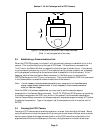Section 2 - Introduction to CCD Cameras
Page 13
purpose is simply to make a record or catalog the image file for easy identification, a dot matrix
or laser printer should be fine. Inkjet printers are getting very good, though.
2.6. Black and White vs. Color
The first and most obvious appearance of a CCD image is that it is produced in shades of gray,
rather than color. The CCD chip used in SBIG cameras itself does not discriminate color and
the pixel values that the electronics read out to a digital file are only numbers proportional to
the number of electrons produced when photons of any wavelength happen to strike its
sensitive layers.
Of course, there are color video cameras, and a number of novel techniques have been
developed to make the CCD chip "see" color. The most common way implemented on
commercial cameras is to partition the pixels into groups of three, one pixel in each triplet
"seeing" only red, green or blue light. The results can be displayed in color. The overall image
will suffer a reduction in resolution on account of the process. A newer and more complicated
approach in video cameras has been to place three CCD chips in the camera and split the
incoming light into three beams. The images from each of the three chips, in red, green and
blue light is combined to form a color image. Resolution is maintained. For normal video
modes, where there is usually plenty of light and individual exposures are measured in small
fractions of a second, these techniques work quite well. However, for astronomical work,
exposures are usually measured in seconds or minutes. Light is usually scarce. Sensitivity and
resolution are at a premium. The most efficient way of imaging under these conditions is to
utilize all of the pixels, collecting as many photons of any wavelength, as much of the time as
possible.
In order to produce color images in astronomy, the most common technique is to take
three images of the same object using a special set of filters and then recombine the images
electronically to produce a color composite or RGB color image. SBIG offers as an option a
motorized color filter wheel. The accessory is inserted between the telescope and the CCD
head. An object is then exposed using a red filter. The wheel is commanded to insert the green
filter in place, and another image taken. Finally a blue image is taken. When all three images
have been saved, they may be merged into a single color image using SBIG or third party color
software.


















